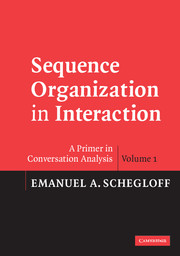Book contents
- Frontmatter
- Contents
- Preface
- Acknowledgments
- 1 Introduction to sequence organization
- 2 The adjacency pair as the unit for sequence construction
- 3 Minimal, two-turn adjacency pair sequences
- 4 Pre-expansion
- 5 The organization of preference/dispreference
- 6 Insert expansion
- 7 Post-expansion
- 8 Topic-proffering sequences: a distinctive adjacency pair sequence structure
- 9 Sequence-closing sequences
- 10 Sequences of sequences
- 11 Retro-sequences
- 12 Some variations in sequence organization
- 13 Sequence as practice
- 14 Summary and Applications
- Appendix 1 Conversation-analytic transcript symbols
- Appendix 2 Transcript of a telephone call
- References
- Index
4 - Pre-expansion
Published online by Cambridge University Press: 05 September 2012
- Frontmatter
- Contents
- Preface
- Acknowledgments
- 1 Introduction to sequence organization
- 2 The adjacency pair as the unit for sequence construction
- 3 Minimal, two-turn adjacency pair sequences
- 4 Pre-expansion
- 5 The organization of preference/dispreference
- 6 Insert expansion
- 7 Post-expansion
- 8 Topic-proffering sequences: a distinctive adjacency pair sequence structure
- 9 Sequence-closing sequences
- 10 Sequences of sequences
- 11 Retro-sequences
- 12 Some variations in sequence organization
- 13 Sequence as practice
- 14 Summary and Applications
- Appendix 1 Conversation-analytic transcript symbols
- Appendix 2 Transcript of a telephone call
- References
- Index
Summary
The first place at which a two-part unit can be expanded is before its first part – hence the term “pre-expansion.” But that immediately confronts us with a question. How can we analyze and understand something like an utterance by reference to something else which has not yet occurred (and, indeed, which may end up never occurring, as we shall shortly see)? What justification might there be for such a procedure if we mean our analysis to be empirically grounded? The answer is that we proceed in that way because that is how the parties to conversation seem to use these exchanges in producing them and in understanding them. The parties to pre-expansion exchanges display an orientation in them to a base adjacency pair which may subsequently develop.
Note that we have already referred to “exchanges” in referring to pre-expansion. Virtually all pre-expansions are themselves constructed of adjacency pairs, and we will therefore regularly refer to them as “pre-sequences” (Sacks, 1992a:685–92 et passim). Both senses of this ambiguous term are relevant and important. They are themselves sequences, and they come before sequences – they are recognizably “pre-,” that is, preliminary to something else. Often the “something else” they are preliminary to is quite specific: it is a first pair part of a particular pair type – an invitation, an offer, a request, an announcement. Preliminaries that project such specific imminent FPPs we will call type-specific pre-sequences– for example, pre-invitations, pre-offers, pre-requests, pre-announcements.
- Type
- Chapter
- Information
- Sequence Organization in InteractionA Primer in Conversation Analysis, pp. 28 - 57Publisher: Cambridge University PressPrint publication year: 2007
- 1
- Cited by



